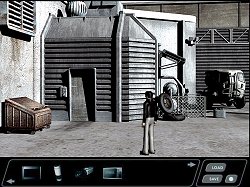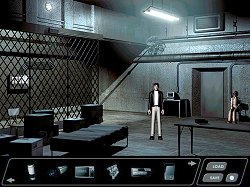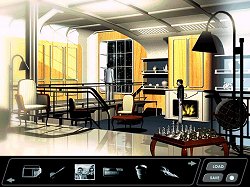|
Zero Critical
 Made in 1997 as Satin Rift, and released in 1999 as Zero Critical, this is an odd little game.
Chatt Rhuller is an Interstellar Transportation Commission Field Agent on assignment to Rhoem 1, a planet of eternal daylight. A research facility has been established there, currently engaged on the SATIN project. Dr Victoria Frayne, Nobel prize winner for Quantum Mechanics and head of the project, has killed a fellow scientist, allegedly in self defence. The incident results in old rumours about the planet causing people to go mad to resurface. You play Chatt, and you are there to investigate the incident.
It's a promising start and for the most part the story lives up to that promise. It is probably the strongest aspect of the game, which may well in itself make it a must play for science fiction adventure fans. Made in 1997 as Satin Rift, and released in 1999 as Zero Critical, this is an odd little game.
Chatt Rhuller is an Interstellar Transportation Commission Field Agent on assignment to Rhoem 1, a planet of eternal daylight. A research facility has been established there, currently engaged on the SATIN project. Dr Victoria Frayne, Nobel prize winner for Quantum Mechanics and head of the project, has killed a fellow scientist, allegedly in self defence. The incident results in old rumours about the planet causing people to go mad to resurface. You play Chatt, and you are there to investigate the incident.
It's a promising start and for the most part the story lives up to that promise. It is probably the strongest aspect of the game, which may well in itself make it a must play for science fiction adventure fans.
If you do play, be prepared for lots of silence. There is absolutely no spoken word anywhere in the game. There are lots of conversations but they are all done in subtitles. Quandary is a fan of subtitles, but not to the exclusion of the spoken word, at least not since this was technologically possible. Zero Critical is well past the age of talkies, but for some reason talking was not used.
There is no doubt much fun was had with games with no talking and whose graphics were a lot more primitive than in this game. It's just that you expect to hear characters talk now, and certainly in a game only 4 or so years old. That they don't is odd to say the least, and it may well be a major turn-off for some.
 Nor is there much in the way of other sound. Apart from the opening score, there is no music - at least there wasn't in my game. There is a credit for the music, and the capacity to turn the music sound up, but no amount of tweaking with the game or fiddling with the soundcard settings would elicit a single note.
There are ambient sounds, but these are minimal - doors make a noise when opened, machinery whirrs, the wind blows outside. Some locations are totally silent, fitting for some but less so for others.
Another thing I found a bit strange is the fact that although you are Chatt, the game addresses you/Chatt in the third person. Instead of musing "I could get there in the truck", you get "Chatt could get there in a truck". Similarly, the common inventory item comment "I can't do that" becomes "Chatt can't do that". The game is played in the third person, but this made the experience that much less personal, and I had to stop myself thinking Chatt was talking to himself in some sort of "royal we" affectation.
Except towards the end, colour is shades of grey and brown. It's a tad drab, but I thought it suited the feel of a sterile research facility in a baron environment. When colour does come, it's almost Oz like, in more ways than one.
The characters look quite good, but are generally static. Chatt walks around, but as with the ambient sounds, other motion is minimal. The other half dozen or so characters will appear though in different places throughout the game. Nor is there much in the way of other sound. Apart from the opening score, there is no music - at least there wasn't in my game. There is a credit for the music, and the capacity to turn the music sound up, but no amount of tweaking with the game or fiddling with the soundcard settings would elicit a single note.
There are ambient sounds, but these are minimal - doors make a noise when opened, machinery whirrs, the wind blows outside. Some locations are totally silent, fitting for some but less so for others.
Another thing I found a bit strange is the fact that although you are Chatt, the game addresses you/Chatt in the third person. Instead of musing "I could get there in the truck", you get "Chatt could get there in a truck". Similarly, the common inventory item comment "I can't do that" becomes "Chatt can't do that". The game is played in the third person, but this made the experience that much less personal, and I had to stop myself thinking Chatt was talking to himself in some sort of "royal we" affectation.
Except towards the end, colour is shades of grey and brown. It's a tad drab, but I thought it suited the feel of a sterile research facility in a baron environment. When colour does come, it's almost Oz like, in more ways than one.
The characters look quite good, but are generally static. Chatt walks around, but as with the ambient sounds, other motion is minimal. The other half dozen or so characters will appear though in different places throughout the game.
 Not surprisingly, the death of the scientist only kicks things off. Once on Rhoem 1, Chatt quickly learns of a longer history to the research facility and of the failed Project Thundercloud. The scientists are suffering disturbed sleep, Dr Vilken sees demons, and the presence of the shady Eugene Garr must be somehow connected to the mystery. And what did happen to the SS Majestic in the Pleiades?
Chatt gets about through the point and click method of perambulation. The cursors are minimal, one for movement, one for interaction and one to speak to a character. You can collect items, indicated by a "take" button when you examine something closely. They are portrayed at the bottom of the screen, and you use them by dragging them into the game screen. You can also examine them by double clicking. It's all very efficient.
Conversations are initiated by clicking on a character or showing them an object. You can choose various paths for the conversations. The dialogue trees can be many, but answers are generally short. You control the speed of the subtitles, one passage not disappearing until you click "continue". You may well get the same conversation more than once, despite having already been told the information, particularly if you show someone the same article more than once. It's not a big thing but it does interrupt the natural flow of the story. On the other hand, this allows you to go back and check on a comment you may have missed.
Puzzles are primarily of the "talk to the right person, find the right object, use it in the right way" variety. They are well integrated into the plot, and none could be called obtuse. They are in fact fairly easy and straightforward, and shouldn't trouble too many gamers for too long.
I read somewhere that Istvan Pely, Zero Critical's designer, said this game was "aimed at the older, casual gamer, who doesn't want to be insulted by poor writing, doesn't want to waste time with lengthy FMV, doesn't want to struggle with irreverent puzzles that exist merely as an excuse for poor gameplay". At least two of those are admirable objectives, and are certainly achieved in the end product.
It's a short casual game that kept me enjoyably occupied for 5 or so hours. Not surprisingly, the death of the scientist only kicks things off. Once on Rhoem 1, Chatt quickly learns of a longer history to the research facility and of the failed Project Thundercloud. The scientists are suffering disturbed sleep, Dr Vilken sees demons, and the presence of the shady Eugene Garr must be somehow connected to the mystery. And what did happen to the SS Majestic in the Pleiades?
Chatt gets about through the point and click method of perambulation. The cursors are minimal, one for movement, one for interaction and one to speak to a character. You can collect items, indicated by a "take" button when you examine something closely. They are portrayed at the bottom of the screen, and you use them by dragging them into the game screen. You can also examine them by double clicking. It's all very efficient.
Conversations are initiated by clicking on a character or showing them an object. You can choose various paths for the conversations. The dialogue trees can be many, but answers are generally short. You control the speed of the subtitles, one passage not disappearing until you click "continue". You may well get the same conversation more than once, despite having already been told the information, particularly if you show someone the same article more than once. It's not a big thing but it does interrupt the natural flow of the story. On the other hand, this allows you to go back and check on a comment you may have missed.
Puzzles are primarily of the "talk to the right person, find the right object, use it in the right way" variety. They are well integrated into the plot, and none could be called obtuse. They are in fact fairly easy and straightforward, and shouldn't trouble too many gamers for too long.
I read somewhere that Istvan Pely, Zero Critical's designer, said this game was "aimed at the older, casual gamer, who doesn't want to be insulted by poor writing, doesn't want to waste time with lengthy FMV, doesn't want to struggle with irreverent puzzles that exist merely as an excuse for poor gameplay". At least two of those are admirable objectives, and are certainly achieved in the end product.
It's a short casual game that kept me enjoyably occupied for 5 or so hours.
Copyright © Steve Ramsey 2002.
All rights reserved.
System Requirements:
Windows 95/98, Pentium 90, 16 MB RAM, 8 bit graphics card, 2x CD ROM, 80 MB disc space, QuickTime 2.1.1 (included)
PowerMac or 68040, System 7, 16 MB RAM, 256 colours, 2x CD ROM, 80 MB disc space, QuickTime 3 (included)
|
